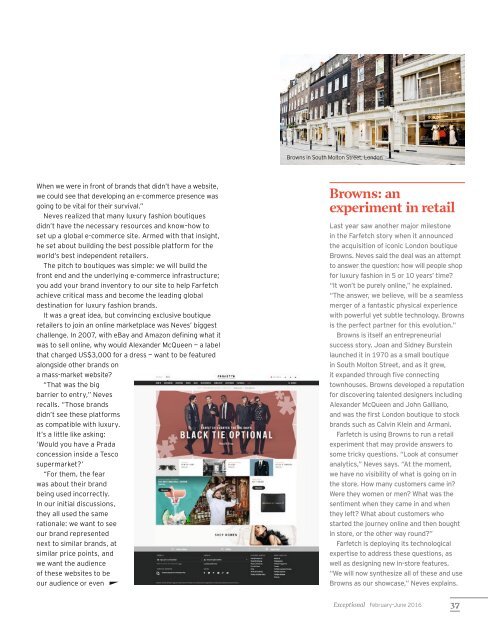Exceptional
1QVzHES
1QVzHES
You also want an ePaper? Increase the reach of your titles
YUMPU automatically turns print PDFs into web optimized ePapers that Google loves.
Browns in South Molton Street, London<br />
When we were in front of brands that didn’t have a website,<br />
we could see that developing an e-commerce presence was<br />
going to be vital for their survival.”<br />
Neves realized that many luxury fashion boutiques<br />
didn’t have the necessary resources and know–how to<br />
set up a global e-commerce site. Armed with that insight,<br />
he set about building the best possible platform for the<br />
world’s best independent retailers.<br />
The pitch to boutiques was simple: we will build the<br />
front end and the underlying e-commerce infrastructure;<br />
you add your brand inventory to our site to help Farfetch<br />
achieve critical mass and become the leading global<br />
destination for luxury fashion brands.<br />
It was a great idea, but convincing exclusive boutique<br />
retailers to join an online marketplace was Neves’ biggest<br />
challenge. In 2007, with eBay and Amazon defining what it<br />
was to sell online, why would Alexander McQueen — a label<br />
that charged US$3,000 for a dress — want to be featured<br />
alongside other brands on<br />
a mass-market website?<br />
“That was the big<br />
barrier to entry,” Neves<br />
recalls. “Those brands<br />
didn’t see these platforms<br />
as compatible with luxury.<br />
It’s a little like asking:<br />
‘Would you have a Prada<br />
concession inside a Tesco<br />
supermarket?’<br />
“For them, the fear<br />
was about their brand<br />
being used incorrectly.<br />
In our initial discussions,<br />
they all used the same<br />
rationale: we want to see<br />
our brand represented<br />
next to similar brands, at<br />
similar price points, and<br />
we want the audience<br />
of these websites to be<br />
our audience or even<br />
Browns: an<br />
experiment in retail<br />
Last year saw another major milestone<br />
in the Farfetch story when it announced<br />
the acquisition of iconic London boutique<br />
Browns. Neves said the deal was an attempt<br />
to answer the question: how will people shop<br />
for luxury fashion in 5 or 10 years’ time?<br />
“It won’t be purely online,” he explained.<br />
“The answer, we believe, will be a seamless<br />
merger of a fantastic physical experience<br />
with powerful yet subtle technology. Browns<br />
is the perfect partner for this evolution.”<br />
Browns is itself an entrepreneurial<br />
success story. Joan and Sidney Burstein<br />
launched it in 1970 as a small boutique<br />
in South Molton Street, and as it grew,<br />
it expanded through five connecting<br />
townhouses. Browns developed a reputation<br />
for discovering talented designers including<br />
Alexander McQueen and John Galliano,<br />
and was the first London boutique to stock<br />
brands such as Calvin Klein and Armani.<br />
Farfetch is using Browns to run a retail<br />
experiment that may provide answers to<br />
some tricky questions. “Look at consumer<br />
analytics,” Neves says. “At the moment,<br />
we have no visibility of what is going on in<br />
the store. How many customers came in?<br />
Were they women or men? What was the<br />
sentiment when they came in and when<br />
they left? What about customers who<br />
started the journey online and then bought<br />
in store, or the other way round?”<br />
Farfetch is deploying its technological<br />
expertise to address these questions, as<br />
well as designing new in-store features.<br />
“We will now synthesize all of these and use<br />
Browns as our showcase,” Neves explains.<br />
<strong>Exceptional</strong> February–June 2016<br />
37


